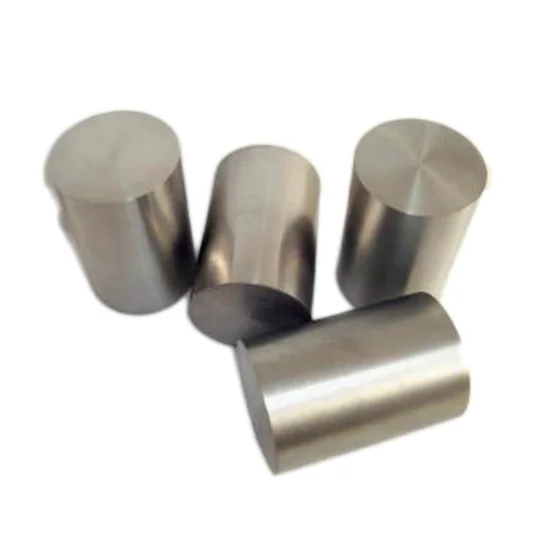Fushun Inconel Alloy 625 Nickel Based Superalloy Round Bar
Περιγραφή

Inconel 625 has excellent strength at temperatures up to 816℃. At higher temperatures, its strength is generally lower than that of other solid solution strengthened alloys. Inconel 625 has good oxidation resistance at temperatures up to 980℃ and shows good resistance to aqueous corrosion, but is relatively moderate compared to other more capable corrosion resistant alloys.
Εφαρμογή
Chemical process industry and sea water application. Inconel 625 is used in short term applications at temperatures up to 816℃. For long term service, it is best restricted to a maximum of 593℃, because long term exposure above 593℃ will result in significant embrittlement.
Grade Comparison
AMS: 5599, 5666, Κυρία: 5837, ASME: SB 443 Gr 1, SB 446 Gr 1, ASTM: σι 443 Gr 1, σι 446 Gr 1, ΣΕ: 2.4856, ISO: 15156-3, NACE: MR0175-3, UNS: N06625, Werkstoff: 2.4856
Cr | Mo | Co | Nb+Ta | Al | Ti | ντο | Fe | Mn | Ni |
20-23 | 8-10 | 1 | 3.15-4.15 | 0.4 | 0.4 | 0.1 | 5 | 0.5 | Balance |
Κατάσταση | Form | Ultimate Tensile Δύναμη, ksi (MPa) | Yield Δύναμη στο 0.2% offset,ksi (MPa) | Elongation in 2″ percent | Σκληρότητα, Rockwell | |
Annealed at 1925°F (1052°C), rapid cooled | Sheet 0.014-0.063″ thick | 132.0 (910) | 67.9 (468) | 47 | B94 | |
Annealed at 1925°F (1052°C), rapid cooled | Sheet,0.0.78-0.155″ thick | 131.5 (907) | 67.4 (465) | 45 | B97 | |
Annealed at 1925°F (1052°C), rapid cooled | Plate, 1/4″ 1/2″ 3/4″ 1.00″ 1-1/2″ 1-3/4″ | 132.0 (910) 130.0 (896) 132.3 (912) 127.2 (877) 127.3 (878) 128.0 (883) | 65.5 (452) 67.0 (462) 80.0 (552) 75.3 (519) 73.7 (508) 66.0 (455) | 46 44 44 42 43 44 | B94 B98 B98 B97 B97 C20 | |
Spring Temper | 1250 – 1500 | 180 – 225 | – | – | ||
Οχι 1 Temper + Annealed + Aged | 1250 – 1450 | 181 – 210 | -200 προς την +550 | -330 προς την +1020 | ||
Οχι 1 Temper + Aged | 1520 – 1720 | 220 – 250 | Contact Alloy Wire Technical Dept | |||
Spring Temper + Annealed + Aged | 1250 – 1450 | 181 – 210 | -200 προς την +550 | -330 προς την +1020 | ||
Spring Temper + Aged | 1700 – 1950 | 247 – 283 | Contact Alloy Wire Technical Dept | |||
Alloy 625 has three basic heat treatments:
(1)High Solution Anneal – 2000/2200°F (1093/1204°C), air quench or faster.
(2)Low Solution Anneal – 1700/1900°F (927/1038°C), air quench or faster.
(3)Stress Relieve – 1650°F (899°C), air quench.
The time at the above temperatures depends on volume and section thickness. Λωρίδα, for example, would require shorter times than large sections. Temperatures for treatments No. 1 και 2 are generally held for 1/2 προς την 1 hour, 1 προς την 4 hours for treatment No. 3. Treatment No. 1 is not commonly used for applications below 1500°F (816°C). It is generally used above 1500°F and where resistance to creep is important. The high solution anneal is also used to develop the maximum softness for mild processing operations such as cold rolling or drawing.
Treatment No. 2 is the used treatment and develops an optimum combination of tensile and rupture properties from ambient temperatures to 1900°F (1038°C). Ductility and toughness at cryogenic temperatures are also very good.
Treatment No. 3 is recommended for application below 1200°F (649°C) when maximum fatigue, hardness, tensile and yield strength properties are desired. Ductility and toughness at cryogenic temperatures are excellent. When a fine grain size is desired for fatigue, tensile and yield strengths up to 1500°F (816°C), treatment No. 3 is sometimes used.
Hot Working
Hot working may done at 2100°F (1149°C) maximum furnace temperature. Care should be exercised to avoid frictional heat build-up which can result in overheating, exceeding 2100°F (1149°C). Alloy 625 becomes very stiff at temperatures below 1850°F (1010°C).
Work pieces that fall below this temperature should be reheated. Uniform reductions are recommended to avoid the formation of a duplex grain structure. Approximately 15/20% reduction is recommended for finishing.
Cold Forming
Alloy 625 can be cold formed by standards methods. When the material becomes too stiff from cold working, ductility can be restored by process anneal.
Machineability
Low cutting speeds, rigid tools and work piece, heavy equipment, ample coolant and positive feeds are general recommendations.
Corrosion Resistance
Alloy 625 has withstood many corrosive environments. In alkaline, salt water, fresh water, neutral salts, and in the air, almost no attack occurs. The nickel and chromium provide resistance to oxidizing environments. Nickel and molybdenum provide for resistance to nonoxidizing atmospheres. Pitting and crevice corrosion are prevented by molybdenum. Niobium stabilizes the alloy against sensitization during welding. Chloride stress-corrosion cracking resistance is excellent. The alloy resists scaling and oxidation at high temperatures.
Pickling
Sodium hydride baths are necessary to descale this alloy. After the sodium hydride treatment, the material should be immersed in a sulfuric acid bath 165°F (74°C) for approximately 3 λεπτά. A 25-minute immersion in a nitric-hydrofluoric bath 145°F (63°C) is then necessary. Rinse. Sulfuric solution: 16% by weight, H2SO4. Nitric solution: 8% HNO3 by weight and 3% HF by weight. Acid etching for macro-inspection-expose material electrolytically to a 3-to-1 HCl to HNO3 solution, saturated with CuCl2 at a current density of 0.645 amp/in² (25.4 A/m)



FAQ
Επιπλέον πληροφορίες
| Τόπο καταγωγής: | Κίνα |
|---|---|
| Τύπος: | Nickel Bar |
| Εφαρμογή: | high temperature |
| Βαθμός: | Inconel Alloy 625 |
| Ni (Ελάχ): | 70% |
| Powder Or Not: | Not Powder |
| Ultimate Strength (≥ MPa): | 80,000 psi (550 MPa) |
| Elongation (≥ %): | 14,000 (965 MPa) 30 (ελάχ) |
| Αριθμός μοντέλου: | Inconel Alloy 625 |
| Μάρκα: | fushun |
| Similar grades: | 2.4856 |
